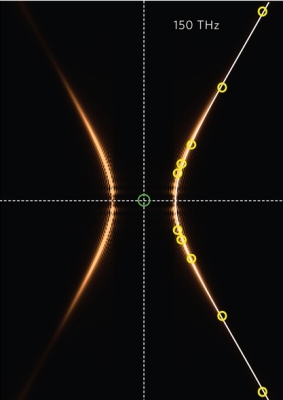A research team directed by scientists from the Lawrence Berkeley National Laboratory of the U.S. Department of Energy and the University of California Berkeley has created nano-scale three-dimensional (3D) optical cavities that are capable of generating the most powerful nanolaser beams.
 Indefinite optical cavities feature a hyperboloid iso-frequency contour that supports ultrahigh optical refractive indices. This cross-section shows the IFC (bronze curves) for a silver/germanium metamaterial with yellow circles representing cavity wave vectors and the green circle representing the light cone of air. (Courtesy of Xiang Zhang group)
Indefinite optical cavities feature a hyperboloid iso-frequency contour that supports ultrahigh optical refractive indices. This cross-section shows the IFC (bronze curves) for a silver/germanium metamaterial with yellow circles representing cavity wave vectors and the green circle representing the light cone of air. (Courtesy of Xiang Zhang group)
With remarkable electromagnetic properties, these exceptional optical cavities also find use in a variety of technologies, which include photonic integrated circuits, quantum optics, nonlinear optics, optical sensing, and LEDs. For making their 3D optical cavities, the researchers created an ‘indefinite metamaterial’ by alternating ultrathin silver and germanium layers. The study results have been reported in Nature Photonics.
The paper’s corresponding author, Xiang Zhang informed that the study paves the way to design an actual nano-scale optical cavity. Optical cavities are crucial elements in majority of lasers. Cavities made of natural optical materials cannot have a size lesser than the wavelength of the light traversing through them.
On the other hand, metamaterials are fabricated using a combination of insulators (dielectrics) and metals, of which dielectrics get polarized in an electromagnetic field. Hence, unlike natural optical materials, metamaterials’ optical properties are derived from their structure instead of their chemical composition. Lead author, Xiaodong Yang stated that the 3D optical cavities can be one-tenth the size of the light wavelength because of the metamaterials’ very high refractive index.
At this nanoscale, the optical mode is compressed into a small space by these optical cavities, causing an increase in the photon density of states, which in turn improves the light-matter interaction. Moreover, resonance frequency can be the same for cavities with various sizes, thus providing more options in designing optical cavities. Moreover, reduced photon loss due to the smaller size of the cavities can help design future nanoscale lasers.
The researchers used germanium as the dielectric due to its higher refractive index of 4.0. They cut the alternating 20-nm-thick silver and 30-nm-thick germanium layers into cubes of different sizes, relying on the count of metal and dielectric layers. They then modified the cube walls into a trapezoid shape with a nano-scale optical cavity in the center.
According to Yang, wave vector space’s hyperboloid iso-frequency contour in these optical cavities enabled the researchers to achieve unprecedented wave vector values, which in turn resulted in unprecedented optical refractive indices as high as 17.4, which is much higher than that of natural materials.